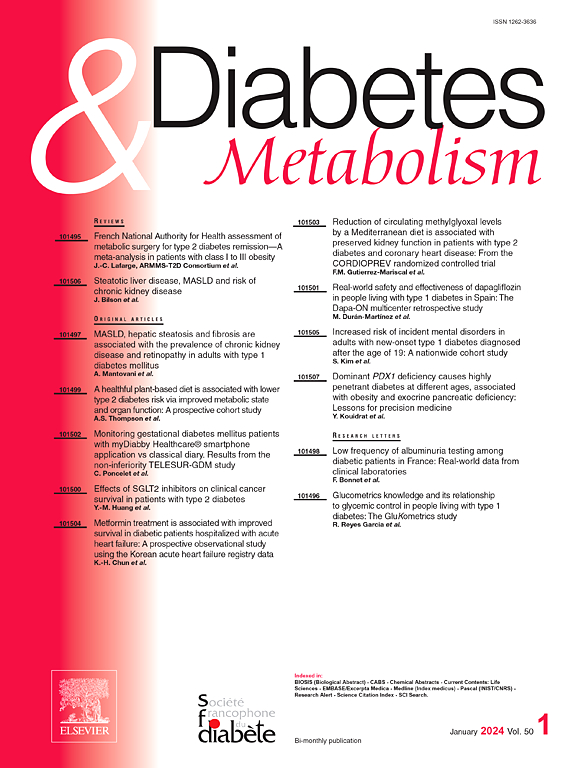Practical implementation of automated insulin delivery systems in 2025: A French position statement update
IF 4.7
2区 医学
Q1 ENDOCRINOLOGY & METABOLISM
引用次数: 0
Abstract
The advent of automated insulin delivery (AID) systems in 2020 marked a disruptive event in managing type 1 diabetes, benefiting children and adults alike. By 2024, advances in real-world data and research motivated an update to the French consensus on AID systems to expand accessibility, refine guidelines, and optimize patient follow-up.
AID systems have consistently improved glycemic control by reducing HbA1c, increasing time-in-range (TIR), and minimizing hypoglycemia, with significant benefits even for specific populations such as individuals with poor glycemic control, brittle diabetes, children, very young children, pregnant women, those with insulin resistance or gastroparesis, or after bariatric surgery. Recent studies support the broadening of AID indications for these special situations, also demonstrating safe transitions directly from multiple daily injections. A careful selection of the most appropriate system for these special situations is essential to achieve optimal personalization for each patient.
Training healthcare professionals and patients remains essential for optimizing AID usage. Updated guidelines emphasize multidisciplinary education, telemonitoring, and individualized follow-up to ensure safety and efficacy.
The potential of fully automated systems and adjunctive therapies, such as GLP-1 receptor agonists, is being explored alongside promising evidence that AID systems improve glycemic control in type 2 diabetes without increasing hypoglycemia. The future of AID systems lies in innovation and expanding their applicability across diverse patient populations.
2025年自动化胰岛素输送系统的实际实施:法国立场声明更新
2020年,自动化胰岛素输送(AID)系统的出现标志着1型糖尿病管理领域的一个颠覆性事件,儿童和成人都将受益。到2024年,现实数据和研究的进步促使法国更新了关于艾滋病系统的共识,以扩大可及性,完善指南并优化患者随访。AID系统通过降低HbA1c,增加时间范围(TIR)和最小化低血糖来持续改善血糖控制,甚至对特定人群(如血糖控制不良的个体,脆性糖尿病,儿童,幼儿,孕妇,胰岛素抵抗或胃轻瘫患者,或减肥手术后)也有显着益处。最近的研究支持扩大针对这些特殊情况的艾滋病适应症,也表明从每天多次注射直接过渡到安全。为这些特殊情况仔细选择最合适的系统对于实现每个患者的最佳个性化至关重要。培训保健专业人员和患者对于优化艾滋病的使用仍然至关重要。更新的指南强调多学科教育、远程监测和个性化随访,以确保安全性和有效性。全自动系统和辅助疗法(如GLP-1受体激动剂)的潜力正在被探索,同时有希望的证据表明AID系统改善2型糖尿病的血糖控制而不增加低血糖。艾滋病系统的未来在于创新和扩大其在不同患者群体中的适用性。
本文章由计算机程序翻译,如有差异,请以英文原文为准。
求助全文
约1分钟内获得全文
求助全文
来源期刊

Diabetes & metabolism
医学-内分泌学与代谢
CiteScore
12.00
自引率
4.20%
发文量
86
审稿时长
13 days
期刊介绍:
A high quality scientific journal with an international readership
Official publication of the SFD, Diabetes & Metabolism, publishes high-quality papers by leading teams, forming a close link between hospital and research units. Diabetes & Metabolism is published in English language and is indexed in all major databases with its impact factor constantly progressing.
Diabetes & Metabolism contains original articles, short reports and comprehensive reviews.
 求助内容:
求助内容: 应助结果提醒方式:
应助结果提醒方式:


